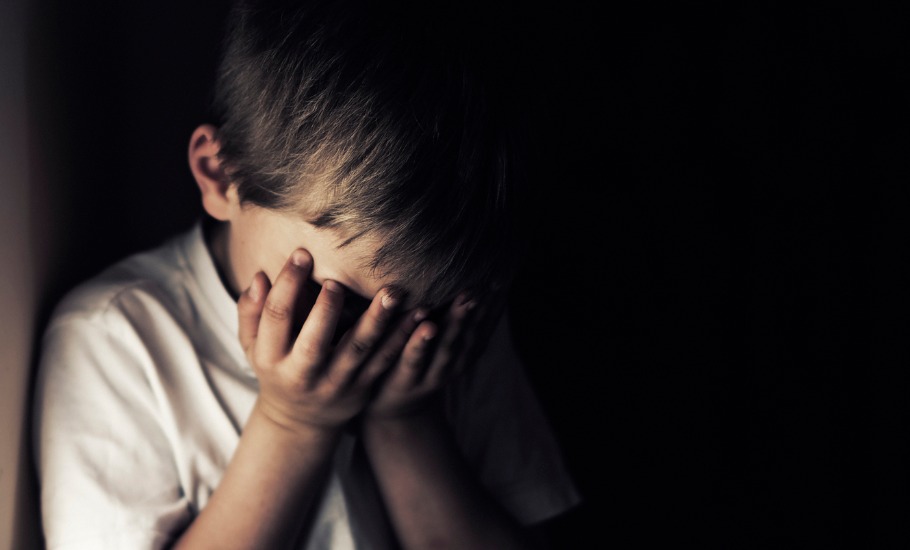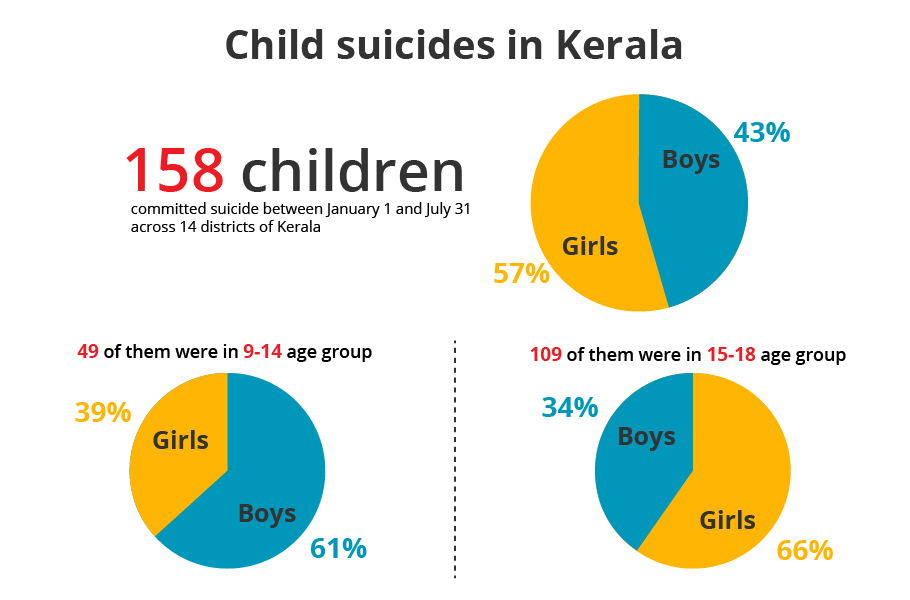
Study on child suicides in Kerala breaks these 7 myths
A study on suicides among children in Kerala has revealed many alarming facts, proving as false several existing notions about the related factors and raises fundamental questions about the safety and mental health of children.

A study on suicides among children in Kerala has revealed many alarming facts, proving as false several existing notions about the related factors and raises fundamental questions about the safety and mental health of children.
The study does not identify lockdown as a factor for suicides as well.
In the second week of July, Chief Minister Pinarayi Vijayan had said 66 children had committed suicide till July 10 since the lockdown came into effect on March 25. He expressed grave concern over the alarming number of child suicides and called for better parental care to help them get over the stress mounted by the lockdown.

Related news: PUBG ban triggers spate of suicides in India
A committee headed by DGP R Sreelekha was appointed to study the problem in depth, which submitted its report to the government on October 21. Following are the major findings of the study which breaks the stereotypes on the mental health of children:
As many as 158 children committed suicide between January 1 and July 31 across 14 districts of Kerala. Of them 57% were girls, the rest being boys.
A whopping 68 per cent of those who committed suicide belong to 15-18 years age groupl; in this group, 66% are girls. On the contrary, boys constitute a major portion (61%) of 49 children in the 9-14 age group who have committed suicide. The youngest to have taken the extreme step was only nine-year-old.
What are the reasons?
One of the major reasons for suicide among girls was found to be love failure; another being the fear of failing in exams. In contrast, the reasons for boys are trivial: scolding by parents, denial of cycle, mobile phone, or TV remote, etc. Wrangle with siblings was also found to be a reason for boys taking their own life.
One alarming finding is that for girls in the age group of 14-17, sexual abuse was found to be a major factor pushing them into suicide.
The class-wise categorisation of the children established a direct correlation with the study pressure. Most children who committed suicide belonged to Class 10 (27%) while 23% were in Class 11, and 18% in Class 12.
The study proves that many existing notions about the mental health of children are fundamentally wrong; following are a few such myths:
- Lockdown escalated suicides among children
The study does not provide any evidence to support this notion; rather it said that being locked in at home was not a reason for the child suicides.
“As per the statistics of the State Crime Records Bureau (SCRB), the number of children who committed suicide during the lockdown period from March 25 to July 10 in 2020 is 66. The number of child suicides in the corresponding period of the previous year is 83. Hence, we may have to infer that lockdown due to Covid-19 as well as online classes have not caused undue stress to the children,” the report said.
2. Children are safe at home
No, they are not. The study reveals that 83% of the children have committed suicide at their homes, 4% at home premises and another 4% at isolated places.
The data also challenges the idea that children are generally not safe and happy in Child Care Institutions. Only 1% of the children who have taken their own lives were living in CCIs. About 84.5 per cent of them have chosen hanging as mode of suicide and 77% committed the act during the daytime in their own homes.
3. Children of single parents and from broken families are more troubled
The data indicates the opposite. About 73% of the children who committed suicide live with both their (biological) parents. Only 9% of them were living with single parents. It is also wrong to assume that children suffer more at the hands of step parents. The number of such children living with one step parent and one biological parent is only six, which is only 4%.
About 83% of children are from nuclear families and 6% from broken families. But researchers have not been able to define or identify what exactly a broken family is. “What is a broken family may not have been explained well or even hidden by those who responded to our questions,” said the report.
4. Children studying in government schools have more freedom and less pressure
Wrong again! Only 18% of the children who committed suicide studied in private schools as against 48% in government schools and 30% in government-aided private schools.
5. Single children are lonely and depressed, those having siblings are happier
The findings of the study indicate that this is a wrong way of understanding children. Parents and two children do not always constitute an ideal family. About 64.5% of the children who committed suicide had one sibling while 21.5% had two. Only 6% of them were single children. There are more alarming reasons other than loneliness that persuade children to take the extreme step.
6. Children with good marks are smarter; they won’t commit suicide
The data proves it wrong. About 32% of them were good in studies and 47.5% were average. Only 18% were recorded as poor in studies.
7. Those who commit suicide have a past history of attempt or mental health issues
This is a dominant myth related to adults. However, the study shows that this notion is wrong, at least in the case of children. About 91% of the children do not have any history of previous attempts. No mental health problems were recorded for 89% of the children.
The study makes the assumption that the absence of any mental health intervention for these 89% children might either be due to no visible clinical problems or it went unnoticed. Those who have a family history of suicides are 16.5%. About 79.5% of children do not have any such family history.
The most alarming factor is that in majority of cases, the reason behind the suicide is “unknown or not clear”. “It is not really true. We assume that the parents know the reason but they are unwilling to share the same,” said one of the members of the committee that conducted the study.
Related news: Child suicides rattle Kerala with bizzare reasons, high numbers
“Suicide is still considered as a matter of shame for the family. Unless we break the taboo around the problems of children, we can never find a solution,” said Dr Arathi P M, feminist scholar and assistant professor at the School of Legal Thought in Mahatma Gandhi University.
About 91% of the children who ended their lives come from the middle and lower income group families which made the committee to assume that financial burden and related problems constitute a major reason for child suicides.
Meanwhile, there are many crucial areas that the study has not touched, including the caste/religious profile. “A committee appointed by the government cannot go into such details,” said TK Anandi, one of the members of the committee. She said such an analysis of caste/community components “would create trouble”.
However, this restraint imposed by the committee itself leaves many questions unaddressed. The district-wise data shows the largest number of children committed suicide were from Malappuram, the only Muslim-majority district in Kerala. This again unsettles a myth that the suicide rate is generally low among the Muslim community as it being considered as ‘haram’, according to the perception of Islam.
Related news: Dalit girl commits suicide for ‘being unable to join online classes’
However, the absence of caste/community profile of the children puts a limit on reaching any conclusion with regard to the same.
“The caste /community profile of the children should have been an indicator of a study like this,” says Dr Rekha Raj, a Dalit scholar and assistant professor at Mahatma Gandhi University. If majority of the children committed suicide are from middle and lower income groups, it would certainly have a connection with the caste status, but in the absence of data, we can’t reach any conclusion,” says Dr Rekha.
Moreover, the silver lining is that there is a declining trend in the number of child suicides reported over the past few years. “Statistics show that in 2014, 330 children died by committing suicide in the State, in 2015 the number was 297 and in 2016 it was 242,” the report added.
(Please reach out to a mental health specialist if you need support or know someone who does. Helplines: AASRA: +91 98204 66726; SAHAI: 080 25497777)

